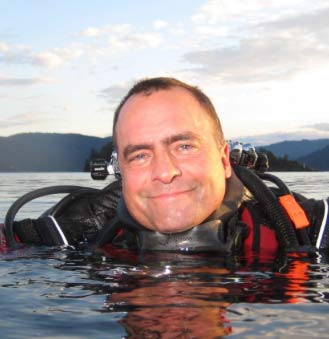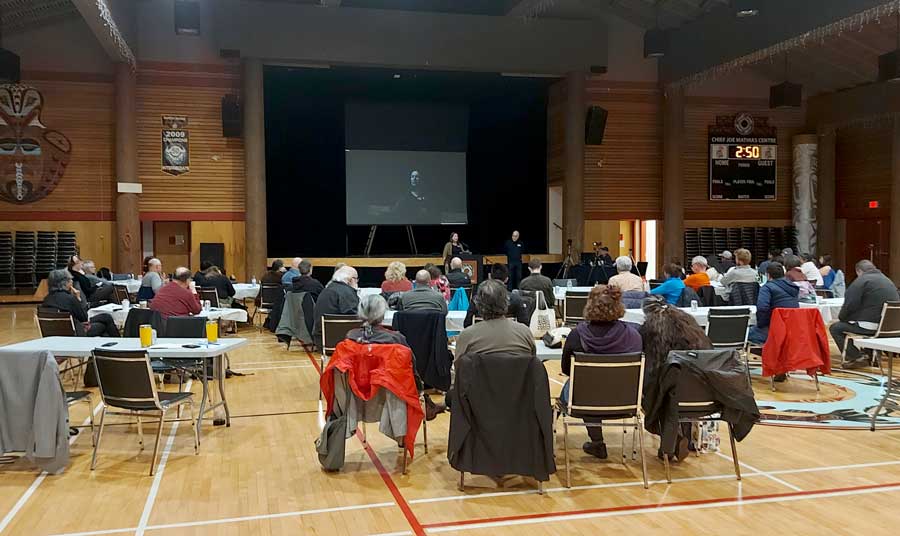First-ever Conference on Indigenous Maritime Archaeology Held in West Vancouver
Words by Matthew Bossons

On April 15, the Underwater Archaeology Society of British Columbia (UASBC) hosted its first-ever annual conference focused exclusively on Indigenous maritime archaeology. The event, appropriately dubbed the Indigenous Maritime Archaeology Conference (IMAC), offered fascinating insights into the pre-colonization history and lifeways of coastal First Nations in B.C. and other Indigenous groups across North America.
In addition to the in-person presentations held on the day at the Squamish Nation’s Chief Joe Mathias Centre in West Vancouver, this year’s lectures were also livestreamed via Zoom to accommodate interested individuals based outside of B.C.’s Lower Mainland.
More than 70 in-person and virtual participants attended the IMAC, including long-time UASBC members, archaeologists and historians, members of local First Nations, and students.
According to conference chair Tom Beasley, this year’s conference was both the UASBC’s first time livestreaming an event and its first time hosting a conference on First Nations’ land — experiences that were “fabulous learning opportunities.”
“The conference was a first for the UASBC, as well as for archaeology in Canada. Maritime archaeology has largely focused on the colonial presence in the country,” says Rob Rondeau, a Ph.D. student and sessional instructor in the Department of Archaeology at Simon Fraser University. Rondeau, who helped organize the event, then took the podium to present new methods and perspectives for finding underwater sites. “There is now a growing awareness of how First Nations people in the past used Canada’s waterways and lived alongside them for many, many generations […] After all, they were this province’s first mariners, and theirs is a rich and meaningful history.”

The conference’s daytime portion started with a blessing song by Squamish Nation’s Chief Billy Williams. Rondeau then took the podium to present new methods and perspectives for finding underwater sites.
Among the many IMAC highlights were Chris Arnett’s introduction to intertidal rock art, Rob Field’s presentation on SGaan Kinghlas, also known as the Bowie Seamount, and Elroy White’s presentation on the Heiltsuk stone fish traps along B.C.’s central coast.
Many of the presentations touched on archaeological work being done in the archipelago of Haida Gwaii, off the coast of B.C. Other lectures highlighted how far underwater exploration technology has advanced in recent years and how novel tech is assisting researchers and archaeologists.
“A consistent theme was how technology has improved over the years, which is allowing archaeologists to make new finds underwater and explore them in ways not previously possible. This includes advancements in underwater bathymetry, the use of remotely operated vehicles (ROVs), and even scuba diving itself,” Rondeau, who also acted as the event’s moderator, tells DIVER. “Diving gear has improved substantially over the last 40 years, allowing divers to stay down longer and dive safer.”
The IMAC’s keynote presentation was provided by Jessi Halligan, assistant professor of anthropology at Florida State University, and drew on her research and marine archaeology experiences to offer expert insights on the peopling of the Americas. She also shared stories from her diving adventures on underwater archaeological sites in Florida.
The UASBC’s next annual conference will be held in Victoria in the spring of 2024 and will focus on shipwrecks. In 2025, the conference will return to Vancouver and again explore the topic of Indigenous maritime archaeology.
About the Underwater Archaeological Society of British Columbia:
The UASBC, formed in 1975, is dedicated to researching, locating, identifying, surveying, and protecting the maritime heritage of B.C. The UASBC’s core activity has been searching for shipwrecks on the coast and interior of B.C. Once wrecks are located, they are surveyed, and reports are written for the B.C. Archaeology Branch.
The UASBC recognizes that trained divers are needed to undertake the surveys. To this end, the society teaches the Underwater Archaeology for Divers course.
The UASBC also realizes that the public is interested in its heritage, so it organizes monthly speakers on various underwater and maritime heritage-related topics. Each spring, the society hosts an annual conference.
The UASBC’s members promote non-intervention and conservation as the best means to preserve the province’s maritime heritage for future generations.
One Response to “First-ever Conference on Indigenous Maritime Archaeology Held in West Vancouver”
Leave a Comment








Robert Hale
Very cool Rob. Nice to have you as a neighbour! Always interesting.